#a.d. 1500
Text
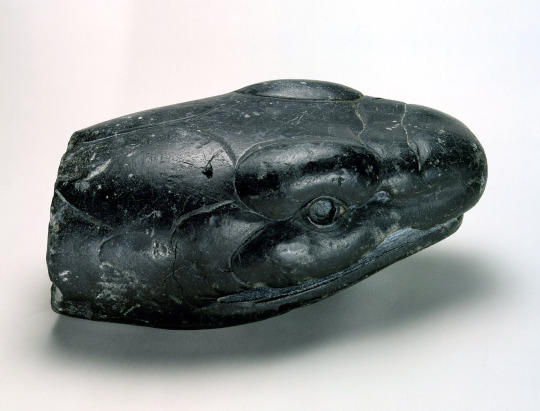
~ Snake Head.
Culture: Aztec
Period: Late Postclassic
Date: A.D. 1200-1520
Medium: Serpentine
#history#museum#archeology#archaeology#aztec#Mexico#mexican#Mesoamerica#snake#snake head#late Postclassic#serpentine#a.d. 1200#a.d. 1500
2K notes
·
View notes
Text
These were from two separate posts but I *NEEDED* them to be united


Ceramic Crab Vessel with Double Spout from the Calima Region Colombia, 1500 B.C.-A.D. 100. And Porcelain Crab Tureen from Jingdezhen, China, 1736-95.
Beautiful. Magnificent. Two artful hand-crafted serving containers whose creation was separated by at least 1500 years and the largest ocean on the planet. Both with the same glorious form.
Carcinisation is eternal
Original posts from @theancientwayoflife (x) and @hieronymusarchives (x)
#in which i say things#art#CRAB DISHES#honestly i love both of these as individual pieces of art and i wanted to see them next to each other
510 notes
·
View notes
Text
Good Omens timeline (as of season 2), from Before the Beginning until the end of season 2:
- “Before the Beginning” — Aziraphale and Crowley meet for the first time.
- 9:13 a.m, Sunday, October 21, 4004 B.C — The creation of the universe (according to God).
- 4004 B.C, "just after the Beginning" — Eve and Adam eat an apple, and then Crowley and Aziraphale have their first on-screen interaction.
- Somewhere between 3070 and 3030 B.C (when Nefertiti was alive), Egypt — Aziraphale presumably impresses Nerfertiti with his magic skills, “You're talking to the Angel who fooled Nefertiti with a lone caraway seed and three cowrie shells.”
- 3004 B.C, Mesopotamia — Aziraphale and Crowley witness the events of Noah's Ark.
- 2500 B.C, the Land of Uz — Aziraphale and Crowley help Job and his family (A Companion to Owls minisode).
- 33 A.D, Golgotha — Aziraphale and Crowley see Jesus’ crucifixion.
- 41 A.D, Rome — Aziraphale and Crowley have oysters.
- 537 A.D., Kingdom of West Essex — Aziraphale and Crowley are knights in King Arthur’s time, and Crowley first suggests “the Arrangement”.
- Sometime in the 1500s (likely between 1503 and 1506 if wikipedia is to be believed), Leonardo Da Vinci’s Studio, Italy — ‘In which Crowley gets drunk with Leonardo Da Vinci’ and buys a sketch of the Mona Lisa for fifteen florins (cut scene from the script book).
- 1601, the Globe Theatre, London — Aziraphale and Crowley meet Shakespeare (who steals a line from Crowley that he uses in Antony and Cleopatra). Crowley also performs a miracle to make Hamlet popular.
- 1650 — The first (known) time that Aziraphale does the apology dance for Crowley.
- 1656, Lancashire, England — the last true witch in England, Agnes Nutter, is burnt by Witchfinder Major Thou-Shalt-Not-Commit-Adultry Pulsifer, who is killed in the process by Agnes’ forward-thinking.
- 1760, Monsieur Rossignol’s Night Classess — Aziraphale learns french the hard way.
- 1793, Paris — Crowley saves Aziraphale from prison during the French Revolution's Reign of Terror (and then they get crepes, as well as Aziraphale doing the apology dance for Crowley).
- 1800, the opening of Aziraphale’s bookshop in Soho — Gabriel and Sandalphon visit Aziraphale to promote him back in heaven. Crowley overhears this, and tricks Gabriel into having Aziraphale stay on earth in order to “thwart him” (cut scene from the script book).
- Sometime before 10th November, 1827, but likely after 1800 — a conman attempts to seduce Aziraphale into helping her “brother” with his debt. Some-point after, Aziraphale tells Crowley of the story over a glass of claret.
- ~A month before 10th November, 1827, Edinburgh, Scotland — Crowley and Aziraphale visit a graveyard with a statue of Gabriel and end up helping a body-snatcher, Crowley also prevents her from committing suicide which results in him being sucked into hell “And that, was the last I was to see of Crowley. For quite some time.” (The Resurrectionists minisode).
- 1859, Aziraphale’s bookshop, Soho — ‘In which Aziraphale almost sells a book’ before receiving a note delivered by a street urchin from Crowley reading ‘the usual place - C’ (cut scene from the script book).
- 1862, St. James Park, London — Crowley requests holy water from Aziraphale for assurance in case anything goes wrong.
- Sometime between 1889 and 1919 (the years Hoffman is alive) but likely around 1876 (the year the book, Modern Magic: A Practical Treatise on the Art of Conjuring is published, that Aziraphale has a signed copy of), England — Aziraphale receives magic lessons from Angelo John Lewis, pseudonym Professor Hoffman, ‘“Aha! Professor Hoffmann's modern magic. Ah, there you are. To Mr. Fell, that's me, a wonderful student” (written) Yours, the Hoff’
- 1941, London — Aziraphale gives prophecy books to some nazis for Hitler, in an attempt to arrest them, only they double-cross him as well. Crowley then comes to Aziraphale's rescue and gives him a lift home, stopping at the West End theatre on the way back . However, the nazis come back as zombies for hell to expose Aziraphale and Crowley’s arrangement, but Aziraphale’s magic thwarts them (Nazi Zombie Flesh Eaters minisode). At some point later on, Aziraphale does the apology dance for Crowley.
- 1967, Soho, London —Crowley arranges a heist (after having gone clothes shopping that morning) to steal holy water from a church with Lance Corporal Shadwell and others. Aziraphale thinks it’s too dangerous, so he gets Crowley holy water himself.
- 1970s, London — Crowley changes the design of the M25 to represent the symbol Odegra, which comes back to bite him later on (as most things do).
- ~2008, “Eleven Years Ago" — Hastur and Ligur deliver the Antichrist to Crowley, who gives it to The Chattering Order of St. Beryl. The Antichrist is then swapped with Deirdre and Arthur Young’s child, while their child, Warlock, goes with Thaddeus and Harriet Dowling. Trying to prevent Armageddon, Aziraphale and Crowley agree to help raise Warlock, the boy they assume is the Antichrist.
- ~2013, “Five Years Later - Six Years Before the End of the World” — Crowley disguises himself as Warlock's nanny, while Aziraphale disguises himself as the Dowlings' gardener.
- ~2019, “Six years later” — the chronological events of season 1 unfold, ending with Aziraphale and Crowley eating at the Ritz.
- Between 2019-2023 — Gabriel and Beelzebub routinely meet in the Resurrectionists pub, where they fall in love.
- ~2023 — the chronological events of season 2 unfold, ending with Aziraphale going up to Heaven and Crowley driving away from the bookshop to destinations unknown (his flat? out of london? out of the uk? out of the world?).
#good omens#good omens 2#spoilers#go2 spoilers#ineffable husbands#good omens timeline#i need someone to stitch together all the scenes chronologically#asap#i just feel like it might make me feel better#(it probably wouldn’t)
109 notes
·
View notes
Video
youtube
Immigrant Song Cover in Old Norse 700 A.D - 1500 A.D (Bardcore or Skäldc...
20 notes
·
View notes
Text
For quite a while, the section “The Bishop in the Presence of an Unknown Light,” was my favourite bit of Les Misérables, and this was my favourite line of that section:
“A cloud had been forming for fifteen hundred years; at the end of fifteen centuries it burst. You condemn the thunderbolt.” [1500 from at little before 1800 gives you somewhere around 300 A.D.; this is far too long to be referring to the Bourbon monarchy - thanks to a friend for the idea that it probably refers to the creation of a state church under Constantine in the A.D. 300s.]
N.K. Jemisin has a line communicating what is, I think, a very similar idea in her Broken Earth trilogy, in a world that is beset by great earthquakes:
When a comm [community] builds atop a fault line, do you blame its walls when they inevitably crush the people inside? No; you blame whoever was stupid enough to think they could defy the laws of nature forever. Well, some worlds are build on a fault line of pain, held up by nightmares. Don’t lament when those worlds fall. Rage that they were built doomed in the first place.
And this us not, in some respects, all that different from what Bishop Myriel himself said in an earlier chapter:
“The faults of women, children, and servants, of the feeble, the indigent, and the ignorant, are the faults of their husbands, fathers, and masters, of the strong, the rich, and the wise…If the soul is left in darkness, sins will be committed. The guilty one is not he who commits the sin, but he who causes the darkness.”
As I’ve learned more detail about the French Revolution, I have become unconvinced of the conventionary’s assertion that it “loosened all the secret bonds of society, made the waves of civilization flow over the earth, is the consecrecration of humanity.” If it destroyed the old tyranny and oppression, it replaced it with a new tyranny and oppression (actual several new ones, from the partisan purge to the ‘managed democracy’ to the military dictatorship); if it removed the old religious intolerance, it replaced it with a new religious intolerance. It was more willing to kill people for following their consciences than the regime of Louis XVI that preceded it, and it encouraged ordinary people to kill not rich oppressors but ordinary neighbours (ref: Murder in Aubagne by D.G.M. Sutherland, a case study on the cycles of violence that came from it becoming socially normal to kill your neighbours for being associated with a different form of republicanism than yourself, and then normal to even kill anyone who agreed with you politically but objected to the murdering).
You condemn the thunderbolt, is, I think, the more convincing assertion - if pressure builds up to a certain point, it will break, like a dam, and the primary blame lies with those who allowed it build up to that point. The argument is not that the dam breaking is the ideal, but that under certain circumstances it is inevitable. Oppression should be fought; reform should be made, firstly for its own sake became it is good and necessary and just and compassionate, and secondly to avert the damage the thunderbolt would do to the innocent; and if that reform is not happening fast enough, the answer is not to say to the suffering, “Be patient!” but to say to the powerful, “Move faster!”
31 notes
·
View notes
Text
Vampire!Price & Elvira Wolff Lore
Even though I've written Vampire!Price twice, I'm going to dump some new lore between Vampire!Price & Elvira Wolff
I have been brainstorming for a while because why not >:)
(And also because I've been too shy to share it lmao)
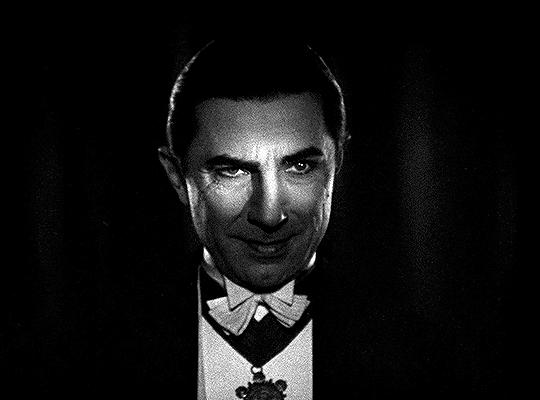
You could say I got heavily inspired by Bram Stoker's Dracula / Castlevania because it's my brainrot ¯\_(ツ)_/¯
ANYWAYS... LETS BEGIN
John Price lore
Captain John Price, also known as "Dracula." "Prince of Darkness." "King of the Night."
Before he became a Vampire was of course a famous captain in the British army in the Medieval era ranging from 500AD to 1500's. John was born at some point in the early 1060 A.D. exactly date, month, was deemed to been long forgotten. The older you get, of course you forget your age and the people around you who are long dead now.
In his human years standing proudly at 190.50 cm / 6ft3 , short brown hair that was always slicked back. His blue eyes shone in the sunlight. Chizzled mutton chops, always neatly shaved regardless of time and place.
At a young age he joined the army, leaving the life he knew behind. He became an excellent swordsman, leader & strategist. He was a young man after all, well built, strong like any man.
Knowing the basic means of survival thanks to all what his father taught him, his father's name forever unknown to everyone else but John.
He sought his enemies to be dead upon the battlefield, always the one to rush into Battle. With his great courage and bravery he quickly became captain, leading his men into Battle with no hesitation. Despite all of the Battles he had won, he wanted more. Of course, John was immensely recognised by his bravery, leadership. He wanted more; He wanted to be King.
At the time had a supposed lover by his side. Despite how forbidden it was for a Knight to have fallen in love with a Princess, he did fall in love with her. He wanted nothing more to take her hand, and make her his. Yet... she soon passed away due to a grave illness, which also made him angry and guilty.
Greed & Power could only get a man so far. With deadly consequences, he betrayed the King, the same one who knighted him all those years ago. Taking the Throne for himself, his other relatives had been slaughtered, taking no second chances. While he sat ever so proudly at the Thone, killing anyone who had defied, dared to betray him.
(That had also meant most of his soldiers for that matter)
To be the Kingdom's forever ruler, John sought out means to possess immortality. He heard of many rumours that of a "Crimson Stone." By any means necessary, the stone got into Price's possession thus he gained immortality. But at a cost.
He became a Vampire. His appearance changed as a whole, all forms of humanity, forms of emotions were gone.
His skin became paler, his ears almost pointed. Teeth sharp like canines, sharp nails that could easily cut you at the slightest touch; Standing now at a staggering height 213cm / 7ft.
With his powers he managed to revive his men forming an undead army, at the bend of his will. Raging War on anyone. With his now gift of immortality, he also gained knowledge of Necromancy & master of Sorcery. Although he gained the common abilities of a Vampire. Price was the most special one of all.
Under the restrained rule of John Price, a band of rebels formed a resistance. A band of powerful sorcerers. With Price's newfound powers, it raged a powerful battle. Almost defeating Price he transformed into a bat, escaping just in the nick of time before his ultimate demise.
One of the sorcerers that almost killed him was a member of the Wolff family. Escaping England for good, moving far away to another foreign land. Yet over time, Supernatural forces grew despite Price's dissappearence, Vampires spawning everywhere causing destruction everywhere.
Soon a Hunters Regieme was formed to tackle the supernatural creatures.
-
Elvira Wolff lore
The Wolff family became strong as the generations went by, one of the many few families built the Hunters Regime, and what it became of in this day and age.
Elvira's mother passed away during birth, so it's been herself and father that stuck through thick and thin. Along with Elvira's godfather, godmother and uncles in their family estate.
Elvira was trained from a young age to be a hunter like her family members, from the age of 5 her training begun. Her knowledge was built on by reading various books about the supernatural creatures; How to fight them, how to deal with them, what to do when you encounter one.
(The list goes on)
By the age of 10 Elvira already had basic knowledge of supernatural creatures, but that was a starting point of her career path.
As she grew older her father got arranged by a Vampire and eventually turned into one. Bit by bit, all forms of humanity dissapeared within him.
Elvira's godparents, and uncles died in the hands of her father as they tried protecting her but to no avail. Dietrich always had the upper hand.
Elvira became a captive in her own home, each night she heard the various screams of men, women, being dragged into the family estate so Dietrich could feed on his eternal hunger.
Elvira did all she could to save them but that would only result in punishment, when she turned 21 in 1476. She risked her life to do the inevitable. Eliminating her father.
She risk burning down her family estate, trapping her father in it. By the time she got out Elvira was gravelly inured, yet she survived.
The Hunters cane and nursed her back to health, yet due to her father's betrayl she had to work hard to regain their trust once more.
Her mission was to kill the Vampire King, John Price. Elvira had everything she needed to make the mission successful.
Yet the moment Price set his eyes on Elvira, the young woman reminded him for his long lost princess... His lover.
#call of duty#cod#call of duty modernwarfare#cod mw#cod modern warfare#captain price#john price#cod oc#oc#ocs#elvira wolff#johnvira
37 notes
·
View notes
Text
We Were Destined To Fall (But I’ll Catch You) [Masterlist]

Pairing: Jeonghan x fem!reader, Seokmin x fem!reader
Featuring: Seokjin, Joshua
Synopsis: In which Yoon Jeonghan traded the fate of humanity for your love.
Genre: Angst, betrayal, greed, hint of fluff, greek myth!au, reincarnation, modern dystopia, historical, time jump/travel(?), one-sided pining/jealousy/implied love triangle (w/Seokmin), bestfriend!seokmin, fallen angel!jeonghan, sinner!reader, blacksmith!seokjin, angel!joshua
Warnings: PG-13, may contain smut (pending), additional warnings specified per chapter. Contains inaccurate representations of history and time.
Disclaimer: Though the intent of this drabble series is not meant to be religious, there are religious references (e.g. angels, heaven vs hell, devil, Greek mythology, mentions of multiple deities rather than one). They are not accurate nor do they necessarily represent mine or SVT's beliefs. All religions are welcomed here.
A/N: Important notes for this series under the cut!
The intent and structure of this series is meant to be unchronological. If the timeline and there seems to be a lot of holes doesn't make sense - good! That's the point. We’ll be skipping between past and present. As the series goes along the pieces will start falling together - promise.
The point in time in which each chapter takes place will be labeled accordingly (e.g. 300 BC vs present day). The chapters labeled "present" refer to the a current timeline revolving around the implied problem in the original drabble!
This au is completely fictional. Fantastical historical, if you will? That said, major events mentioned here are very similar to/inspired by the ones in world history! Present day is a modern dystopia: medieval meets technologically advanced? 😬
This is a drabble series! The chapters are meant to be short (1K-ish or less).
Though the idea came from Jeonghan's character(?) in the HOT MV, the plot was inspired by a multitude of Greek myths, namely Pandora's Box and Icarus and Daedulus.
Updates will be irregular to say the least (I have two ongoing series, one in the works, and drabbles for previous works to finish) . . . I'm publishing this on a whim since I have so many ideas bursting for this series, I couldn't keep it all to myself! I apologize if there are long periods without updates. Thank you be patient with me and waiting to see this unfold.
That said, taglists are the best way to stay updated! Please send an ask if you're interested in being a part of it. This is the best way to keep track of them. DMs and comments are easily lost.

original drabble
prologue [present.]
one [1584 B.C.]
two | [present.]
three | [1769 A.D.]
four | [1572 A.D.]
five | [present.]
six| [1213 B.C.]
seven | [1923 A.D]
eight (1/2) | [1500 B.C]
eight (2/2) | [1500 B.C.]
nine | [present.]
ten | [1927, Paris]
eleven | [present]
twelve | interlude
thirteen (2/2) | [present: seokmin's pov]
other:
bonus i: to give you the stars
[additional chapters TBD. Chapter title/order subject to change.]
#jeonghan x reader#seokmin x reader#yoon jeonghan#lee seokmin#jeonghan angst#jeonghan smut#seokmin angst#seventeen x reader#seventeen angst#seventeen smut#seventeen scenarios#seventeen imagines
488 notes
·
View notes
Photo

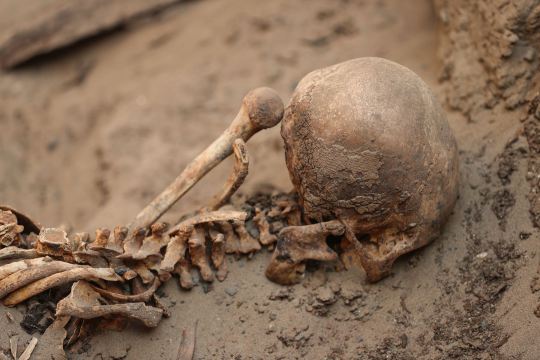

Sea Lord’s 1,000-Year-Old Tomb Uncovered in Peru
Hidden under the tan-brown dirt of Peru, a sea lord’s skeleton rested among the luxuries of the afterlife. Surrounded by sacrifices and offerings, the elite figure was forgotten — until now.
Archaeologists excavating the Macatón cemetery in Huaral uncovered the large tomb, the National Major University of San Marcos said in a May 15 news release.
The 1,000-year-old tomb was about 23 feet deep and about 23 feet wide, the release said. Inside, archaeologists found an elite figure, as well as five other people, four llamas and several pottery vessels.
The burial was left by the Chancay culture, a pre-Incan culture that developed between 1000 and 1500 A.D., the release said.
The tomb’s central elite figure was identified as a sea lord, the excavation’s lead archaeologist Pieter Van Dalen Luna told EFE. The presence of a wooden oar — the first artifact of its kind found at the Macatón cemetery — led to this identification, the outlet reported.
The sea lord was likely dedicated to fishing, shellfish hunting or another marine activity, Van Dalen said.


The burial also contained 25 pottery vessels with offerings of food for the deceased’s afterlife, EFE reported.
The Chancay culture believed deceased individuals did not cease to exist but became protective ancestors through a series of transformative stages on their path to the dead, experts said in the release.
The Chancay culture faded around 1500 A.D. at a time coinciding with the Incan empire’s territorial expansion, EFE reported.
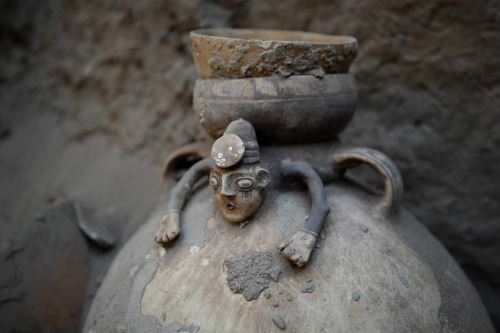

The excavation site is about 165 feet from a neighborhood of homes, BBC reported. These houses are likely preventing archaeologists from uncovering other tombs, but the houses also deterred looters from disturbing the area, archaeologists told the outlet.
The sea lord’s tomb is the oldest and largest tomb of about 80 burials found in the Macatón cemetery so far, BBC reported.
Archaeologists will continue analyzing the remains of the deceased to further understand the burial, the release said.
Haural is about 45 miles northwest of Lima.
By Aspen Pflughoeft.





#Sea Lord’s 1000-Year-Old Tomb Uncovered in Peru#Macatón cemetery#chancay culture#pre-incan culture#ancient tomb#ancient grave#skeleton#pottery#ancient artifacts#archeology#archeolgst#history#history news#ancient history#ancient culture#ancient civilizations#long reads
63 notes
·
View notes
Text
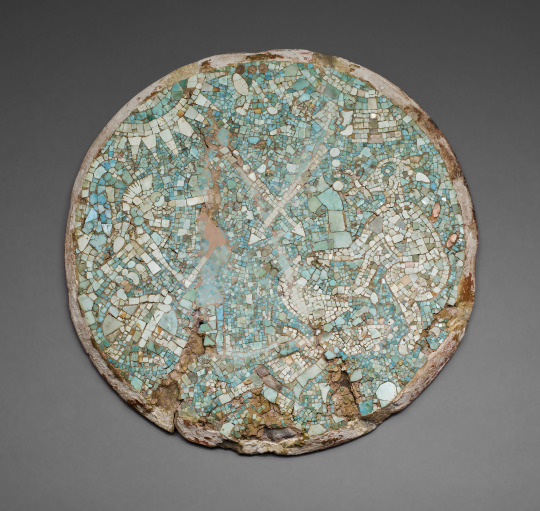
Mosaic Disk with a Mythological and Historical Scene
Mixtec, 1400–1500 CE
On this disk, the sign for “year” and the date “3 Flint- Knife” (A.D. 1456) are associated with the image of the sun on the left; the date “4 House” (A.D. 1457) is linked by footsteps to the sun on the right. These dates mark the end of one 52-year cycle and the beginning of a new one. In the center, crossed darts symbolize a military alliance. Alliance members are represented by the skeletal figure at the left and the animal figure at the right. Below, a prone human form (damaged) signifies a sacrifice to confirm the association. The imagery of the disk stems from a long-established Mixtec tradition of pictorial manuscripts.
10 notes
·
View notes
Text
Why is Wednesday spelled that way?

Randy Roshi · (Quora)
Follow
I teach college courses in English linguistics and writing.
“Wednesday” is a very old word, going back to times so long ago as to predate our modern ideas about spelling. I’ve been looking into the OED for some attestations of the word, and here is a representative (but not complete) list:
wodnesdæg (990 A.D.)
Wodnesdei (1123)
Weodnesdei (1225)
Wendesdei (1300)
wodnes day (1325)
Wednesday (1450)
wonysday (1475)
Wenysday (1500)
wednysday (1515)
Wednesdaye (1562)
wensdaie (1574)
Wensday (1616)
Weddinsday (1639)
Wednesday (1681)
All the OED’s attestations following 1681 are spelled the same as that last one. Around that time, modern ideas about spelling were getting established. In older times, writers did their best to represent the way words were pronounced. Then, as now, people were likely to encounter a wide variety of pronunciations, but were inclined to write in a way that recorded whichever pronunciations were highest in prestige for their own time and place.
Wednesday got its name from Odin, or Wodin, one of the Norse gods. The “es” at the end of his name is the same possessive “s” that we still use today, although now we always drop the vowel and pop in an apostrophe.
The name “Wodin” got shortened to “Wodn” through a process called syncope. Then the “o” changed to “e” because of something called vowel harmony. Although vowel harmony doesn’t take place in modern English as a regular process, it was quite regular in Old English times. It meant that the vowel sound in “day” had an influence on the preceding vowel “o” in “Wodn,” changing it to “e.”
16 notes
·
View notes
Text

TALL RING BASE JAR
Clay with polychrome decoration 11" high. Puebla area, Mexico.
Postclassic Period. A.D. 1300-1500
LOS ANGELES MUSEUM OF NATURAL HISTORY
10 notes
·
View notes
Text

~ Flute in the Form of a Snail Shell with Geometric Motifs.
Date: A.D. 1250 - 1500
Prriod: Tuza
Place of origin: South America, Northern Andes, Colombia
Culture: Narino
Medium: Ceramic
#ancient America#flute#snail shell#Geometric Motifs#ceramic#tuza#narino#south America#andes#colombia#a.d. 1250#a.d. 1500#musical instrument#history#archeology#museum
266 notes
·
View notes
Text
Ok, who wants to talk more about the Arthur/Christianity thing...
Boy I sure have a lot to say today... Anyway.
So, I'm watching mythology vids, or rather they're on the background while I draw, and that's just making me think a lot. And right now I've stumbled into a reason why this Christianity thing might actually be important.
See, we don't have a solid timeline. We know, obviously, that Seven Deadly Sins takes place in the ballpark of Arthurian myth. Duh. But when is that exactly? Well, Arthurian legend is set in
"The medieval era, often called The Middle Ages or the Dark Ages, began around 476 A.D. following a great loss of power throughout Europe by the Roman Emperor. The Middle Ages span roughly 1,000 years, ending between 1400 and 1450."
Now I have this quoted in my personal notes, but it was one of the earliest things I looked up, and at the time I never intended to be this academic about any of this, so I don't have citation. The rest of this note, which was written by me for my own reference goes as follows
Boiling down the above for ease of math and concept SDS/4KoA takes place during the medieval era(AKA the middle ages or the dark ages) which span from around 500 CE(A.D). to 1500 CE.
In my paracosm I most often say that there's 500 years till modern day, which is fine if SDS takes place at the late end of that scale. but it's more like 1500 if it's near the beginning, to know for sure we'll have to see how 4KoA ends.
So roughly that. Why does that have anything to do with Christianity. Well... Cuz
The history of Christianity in Scotland goes back to Saint Ninian in 400 CE. He is said to have led a mission to Scotland which resulted in many conversions.
In the 5th Century another influential figure, Saint Columba, arrived on the Scottish island of Iona where he established a monastic community. This worked to spread the Christian gospel in both Scotland and Northern England.
-bbc.co.uk
That one is cited.
So yeah? Depending on exactly where we place 7ds on the timeline, Arthur could be basically bringing Christianity. Which... kinda lines up with what he's doing and kinda... bodes not great for where the story is going o.O
#seven deadly sins#nanatsu no taizai#four knights of the apocalypse#7ds#nnt#4kota#7ds arthur#nnt arthur#4kota arthur#7ds discussion#nnt discussion#7ds analysis#nnt analysis#christianity
9 notes
·
View notes
Note
Vampire the Masquerade question: How could a Tzimische in the dark ages construct Dragula?
As long as we're talking about after the battle of mistridge, it's simplicity itself. The tremere have come on to the scene, and are using their magics to turn captured Tzimisce into gargoyle servants. To at least one of the old clan the answer is clear, mages who become vampires possess strange blood magics. Koldonic sorcery is no longer enough to fight the usurpers. New magic for a new age is required. After the battle of mistridge, the order of Hermes suffer a terrible blow and the artificers guild is born. The Xth iteration they will be known for is still centuries in the future, but their magic is powerful against the hermetics. Perhaps the story of the battle is sold to a vivode by the Nosferatu and servants of terrible design are dispatched to acquire one of these mages. Lured to the old country by revenants who promise funding and a powerful patron for him to develop his arts. The resulting embrace? A technomantic Tzimisce in the year of our Lord 1500 a.d.
Several pipe organs and an enchanted racing chariot from an even earlier age give their lives to support the technocratic engine that will power Dragula. It's Creator vanishes into obscurity, but it does see use in the battle against the tremere. War ghouls and hot rods in a dark crusade prevents the tremere from gaining a foothold beyond the Forest in Transylvania. The battle resembles death race 2000 sponsored by the cenobites. Centuries later traumatized elders of clan tremere suffer flashbacks as rat fink takes American culture by storm. A malkavian, completely unaware of its significance but guided by The whispers in his head, adds the Dragula to his current prank project, just another hidden jab at vampire history, on display in the completely plausibly deniable Munsters. The first True Dragula remains, having fallen as a possession of the most notorious of the red list kindred, and on the eve of Gehenna, Vlad Tepes Dracula, shall ride it into battle once more.
5 notes
·
View notes
Photo

Timeline Settings
Disney Animated Canon
Fantasia: Rite Of Spring 65,000 BCE
Brother Bear 10,000 Bc
Atlantis The Lost Empire 7000 BC
Fantasia 2000: Pomp And Circumstance 1800 BCE
Firebird Suite 1590 BCE
Fantasia: The Pastoral Symphony) 1277 BCE
Hercules 1179 Bce
The Lion King 1178 Bce
Moana 984 Bce
Maui Gone Fishing short 984 Bce
Ye Olden Days short 800 A.D.
The Sword In The Stone 400s
The Sword In The Stone 400s
The Black Cauldron Dark Ages 570
Fantasia The Sources Apprentice 740
Aladdin 800s
Fantasia Night On Bald Moutian 1025
Robin Hood 1194
Sleeping Beauty 1300s
The Hunchback Of Notre Dame 1482
The Emperor's New Groove -1500
Snow White And The Seven Dwarfs Early 1500s
Pocahontas 1607
Fun And Fancy Free: Mickey And The Beanstal 1734
Beauty & The Beast 1770s
The Adventures Of Ichabod 1790
Melody Time: The Legend Of Johnny Appleseed 1795
Tangled 1820
50th Anniversary Animation Countdown short 1820
Frozen 1820
Tangled Ever After short 1841
Melody Time: Pecos Bill 1858
Alice In Wonderland 1862
Fantasia 2000 The Steadfast Tin Soldier 1865
Cinderella Mid 1860s
Home On The Range Mid 1875s
Fantasia Dance Of The Hours 1876
Tarzan Mid 1882
Disneypedia Living In The Jungle short 1882
Pinocchio 1883
Make Mine Music: The Martins And The Coys 1885
Make Mine Music: The Whale Who Wanted To Sing At The Met 1886
Make Mine Music Casey At The Bat 1888
Make Mine Music Johny Fedora And Alice Bluebonnet 1889
Melody Time Once Upon A Wintertime 1890
The Little Mermaid Mid 1890s
Fantasia Nutcraker 1892
The Jungle Book 1893
Basil The Great Mouse Detective 1897
So You Think You Can Sleuth short 1897
Peter Pan 1900
Mr Toad 1906
Lady & The Tramp 1908
The Aristocats 1910
Atlantis The Lost Empire 1914
Fantasia 2000 Pines Of Rome 1924
The Many Adventures Of Winnie The Pooh 1926
Winnie The Pooh And A Day For Eeyore Short 1926
Mini Adventures Of Winnie The Pooh Short 1926
Winnie The Pooh 1926
The Ballad Of Nessie Short 1926
Get A Horse Short 1928
Fantasia 200 RHAPSODY BLUE 1932
The Flying Mouse short 1934
"The Band Concert short 1935
"
Make Mine Music Peter And The Wolf 1936
Make Mine Music Blue Bayou 1936
"Elmer Elephant short 1936
"
Thru the Mirror short 1936
Three Blind Mouseketeers short 1936
The Old Mill short 1937
Farmyard Symphony short 1938
The Brave Little Tailor short 1938
Paperman Short 1940
"Lend a Paw Short 1941
"
Dumbo 1941
Fun And Fancy Free Bongo 1941
The Reluctant Dragon short 1941
Saludos Amigos 1942
South Of The Border With Disney short 1942
Bambi 1942
Symphony Hour short 1942
The Three Caballeros 1944
Make Mine Music All The Cats Join In 1946
"A Knight for a Day short 1946
"
Bath Day short 1946
Melody Time Little Toot 1948
"Pueblo Pluto short 1949
"
"Puss Cafe short 1950
"
"Lambert the Sheepish Lion short 1951
"
Donald Applecore short 1952
Water Birds short 1952
"Trick or Treat short 1952
"
Don's Fountain of Youth short 1953
Casey Bats Again short 1954
Grand Canyon short 1958
101 Dalmatians 1961
Rescuers 1-2 1970s
inner workings short 1980s
The Fox & The Hound 1981
Oliver & Company 1988
Fantasia 2000: The Carnival Of The Animals 1999
Lilo & Stitch 2002
Chicken Little 2002
Easter Egg Runt On The Litter short 2002
Easter Egg Foxy Loxy Short 2002
Meet The Robinsons 2007
Keep Moving Forward Invention short 2007
Bolt 2008
Super Rhino short 2008
Wreck-It Ralph 2012
Big Hero 6 2014
Feast short 2014
Tokyo Go short 2014
Zootopia 2016
Wreck-It Ralph 2 2018
Meet The Robinsons 2037
Treasure Planet 10000000000000000000...
20 notes
·
View notes
Text
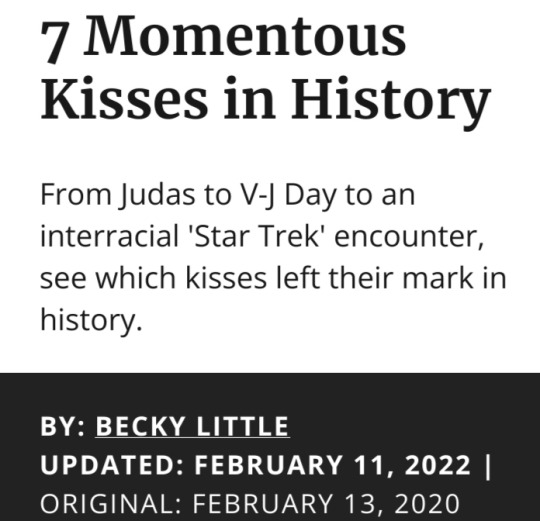
Despite what the song says, a kiss isn’t always just a kiss.
A kiss can be political, because it’s the first of its kind or because it’s between two heads of state.
A kiss can also become iconic when it’s captured on film, even if the kiss itself was invasive and unwanted.
With that in mind, here’s a list of some of the most memorable kisses in history.
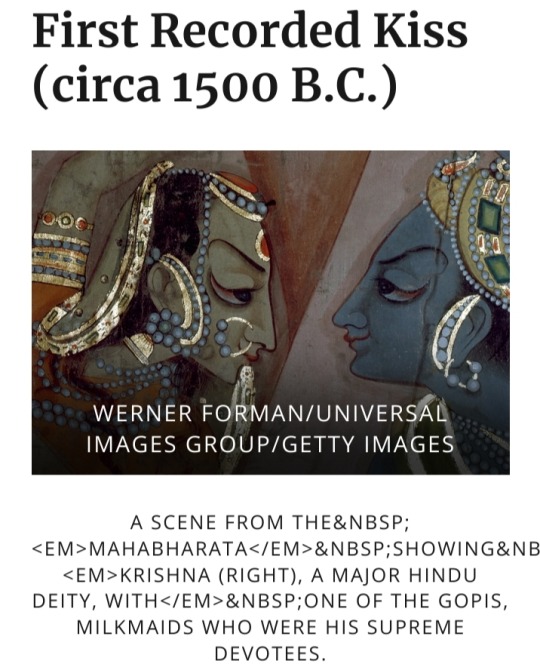
Scholars debate whether kissing began as a trend that spread around the globe, or sprung up organically in different regions.
Whatever the case, the earliest known written mentions of it are in Vedic Sanskrit scriptures circa 1500 B.C., according to research by Vaughn Bryant, an anthropology professor at Texas A&M University.
These scriptures, known as the Vedas, were foundational to the religion of Hinduism.
After that, kissing continued to appear in ancient Indian and Hindu literature.
The Mahabharata, a Sanskrit epic compiled by the 4th century A.D., has a line in which someone “set her mouth to my mouth and made a noise that produced pleasure in me.”
The Kama Sutra, an ancient Sanskrit text on eroticism and love, also has a chapter on kissing that identifies different methods of kissing and types of kisses.
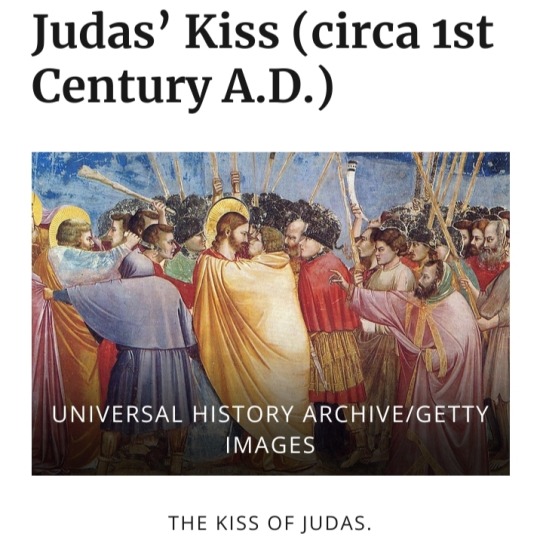
Kissing isn’t just a romantic act. It can also be a sign of friendship or betrayal.
In the Gospels of Matthew and Mark, written circa the 1st century, Judas betrays Jesus by identifying him with a kiss so that armed men can take him away and eventually kill him.
Judas’ kiss has since become a popular storytelling allusion.
It may have inspired the “kiss of death” that appears in mafia literature and film (but was probably never an actual mafia practice).
Perhaps the most famous example is in The Godfather Part II, when Al Pacino’s character gives his brother Fredo the kiss of death for betraying him.
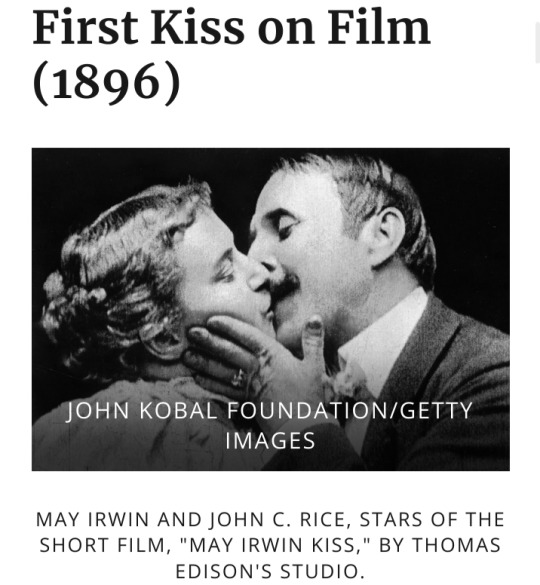
The first people to smooch on film were May Irwin and John C. Rice, who appeared in a short film known variously as May Irwin kiss, Kiss, or The Kiss.
In 1896, the two performers went to Thomas Edison’s studio in New Jersey and reenacted their final kiss scene from a play they were putting on in New York City.
On stage, no one thought the kiss was that sensational. But many felt the close-up footage of them kissing was too risqué.
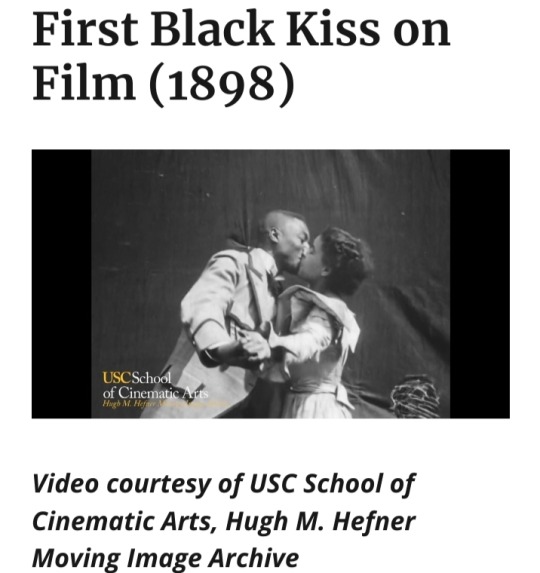
In 1898, black performers Saint Suttle and Gertie Brown starred in a short film titled ''Something Good-Negro Kiss,'' the first film to show Black Americans kissing.
In 2017, film historians rediscovered the footage, which was filmed by a white man named William Selig in Chicago.
“There’s a performance there because they’re dancing with one another, but their kissing has an unmistakable sense of naturalness, pleasure and amusement as well,” Allyson Nadia Field, a professor of cinema and media studies at the University of Chicago who helped identify the film, said in a university press release.
“It is really striking to me, as a historian who works on race and cinema, to think that this kind of artifact could have existed in 1898.”

On the morning of 14 August 1945, patients burst into Greta Zimmer’s Manhattan office claiming the war in Japan was over.
The Austrian immigrant wasn’t sure what to think, so on her lunch break, she went to Times Square in her white dental assistant’s uniform to see what the news ticker said.
The atmosphere there was celebratory. The ticker confirmed that it was indeed V-J Day, and World War II was over.
As Zimmer looked away from the ticker, a Navy sailor named George Mendonsan — who’d started drinking early and mistook Zimmer for a nurse — ran up and aggressively kissed her, leaving his girlfriend behind.
Zimmer struggled to push the stranger off, and they parted ways.
But unbeknownst to both of them, photographers Alfred Eisenstaedt and Victor Jorgensen had each captured the moment, as recounted in The Kissing Sailor: The Mystery Behind The Photo That Ended World War II.
Eisenstaedt’s photo became one of the most iconic WWII images in U.S. history, in part because viewers mistook it for a picture of a Naval officer and nurse celebrating together.
The photo has also stirred controversy, as many people have claimed over the years to be the couple in the image, while others point out that it depicts a nonconsensual moment.
Zimmer said in an interview with the Library of Congress in 2005:
“It wasn’t my choice to be kissed...the guy just came over and kissed or grabbed!”
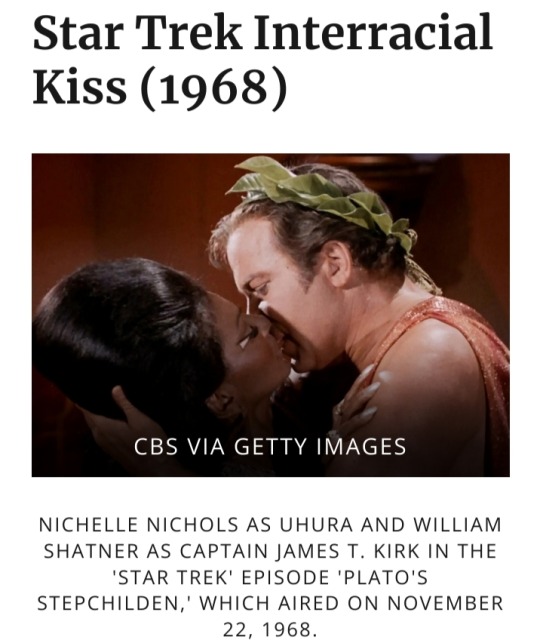
When William Shatner and Nichelle Nichols kissed on a 1968 episode of Star Trek, it was not technically the first interracial kiss on U.S. television.
But it was the one that seemed to have the most cultural impact.
In the episode, titled “Plato’s Stepchildren,” Captain James Kirk and Officer Nyota Uhura encounter aliens who force them to kiss each other through telekinesis.
In Nichols’ book Beyond Uhura: Star Trek and Other Memories, she recalls that NBC was worried how white Americans would react to the scene, so they asked the actors to film two scenes: one with a kiss and one without a kiss.
However, Nichols and Shatner purposefully messed up all of the kissless takes in order to ensure that NBC aired the kissing scene.

During the Cold War, leaders of communist states often greeted each other with what’s called the “socialist fraternal kiss.”
This could be on the cheek or the mouth, but the most famous example is French photographer Régis Bossu’s 1979 picture of the Soviet Union’s Leonid Brezhnev and East Germany’s Erich Honecker kissing on the mouth.
The kiss occurred when Brezhnev visited East Berlin to celebrate the 30th anniversary of the German Democratic Republic (i.e., East Germany).
When the Berlin Wall came down in 1989, the Soviet artist Dmitri Vrubel recreated the image in a mural on the wall’s east side.
He captioned it: “My God, Help Me to Survive This Deadly Love.”
#Memorable Kisses in History#kiss#history#Vedic Sanskrit scriptures#Vedas#The Mahabharata#The Kama Sutra#Judas#Jesus#May Irwin#John C. Rice#Saint Suttle#Gertie Brown#William Selig#Greta Zimmer#Alfred Eisenstaedt#Victor Jorgensen#V-J Day#World War II#Star Trek#William Shatner#Nichelle Nichols#Socialist Fraternal Kiss#Régis Bossu#Leonid Brezhnev#Erich Honecker#German Democratic Republic#Berlin Wall#Dmitri Vrubel#Judas Kiss
2 notes
·
View notes